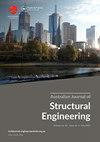具有完整约束的建筑物的建模和结构控制
IF 1.3
Q4 ENGINEERING, CIVIL
Australian Journal of Structural Engineering
Pub Date : 2022-10-02
DOI:10.1080/13287982.2022.2049072
引用次数: 0
摘要
在这项研究中,我们提出从机械阻抗和结构储存能量的峰值来评估结构控制系统。我们的主要假设是,机械阻抗越高,结构达到的能量峰值越低。该峰值计算为地震注入的能量与粘性阻尼器作为热量消散的能量之差的最大值。为了支持我们的说法,我们对一个三层平面建筑进行了数值模拟,该建筑由12个转动关节和4个移动关节组成。我们没有使用线性质量-弹簧-阻尼器模型,而是模拟了一组由牛顿-欧拉(NE)算法给出的非线性方程。牛顿-欧拉(NE)算法在机器人技术中广泛使用,但在结构控制中很少使用。对于能量耗散,我们比较了比例导数(PD)和计算扭矩控制(CTC)。仿真结果表明,在结构参数完全已知的情况下,旋转关节和移动关节相对于其标称值的偏差接近于零。这一特点导致能量耗散几乎为零,但也减少了地震传递给结构的能量。本文章由计算机程序翻译,如有差异,请以英文原文为准。
Modeling and structural control of a building with holonomic constraints
ABSTRACT In this study, we propose to evaluate structural control systems in terms of mechanical impedance and the peak of energy stored by the structure. Our main hypothesis is that the higher the mechanical impedance, the lower the peak of energy reached by the structure. This peak is calculated as the maximum of the difference between the energy injected by the seism and the energy dissipated as heat by viscous dampers. To support our claim, we performed numerical simulations on a three-story planar building comprising 12 revolute and four prismatic joints. Instead of using a linear mass-spring-damper model, we simulated a set of nonlinear equations given by the Newton-Euler (NE) algorithm, which has been widely used in robotics, but rarely in structural control. For energy dissipation, we compared a proportional derivative (PD) with a computed torque control (CTC). Simulation results for the CTC indicate that when all parameters of the structure are perfectly known, the deviations of the revolute and prismatic joints with respect to their nominal values are close to zero. This feature leads to almost null energy dissipation, but also reduces the energy transferred by the seism to the structure.
求助全文
通过发布文献求助,成功后即可免费获取论文全文。
去求助
来源期刊

Australian Journal of Structural Engineering
ENGINEERING, CIVIL-
CiteScore
2.50
自引率
0.00%
发文量
31
期刊介绍:
The Australian Journal of Structural Engineering (AJSE) is published under the auspices of the Structural College Board of Engineers Australia. It fulfils part of the Board''s mission for Continuing Professional Development. The journal also offers a means for exchange and interaction of scientific and professional issues and technical developments. The journal is open to members and non-members of Engineers Australia. Original papers on research and development (Technical Papers) and professional matters and achievements (Professional Papers) in all areas relevant to the science, art and practice of structural engineering are considered for possible publication. All papers and technical notes are peer-reviewed. The fundamental criterion for acceptance for publication is the intellectual and professional value of the contribution. Occasionally, papers previously published in essentially the same form elsewhere may be considered for publication. In this case acknowledgement to prior publication must be included in a footnote on page one of the manuscript. These papers are peer-reviewed as new submissions. The length of acceptable contributions typically should not exceed 4,000 to 5,000 word equivalents. Longer manuscripts may be considered at the discretion of the Editor. Technical Notes typically should not exceed about 1,000 word equivalents. Discussions on a Paper or Note published in the AJSE are welcomed. Discussions must address significant matters related to the content of a Paper or Technical Note and may include supplementary and critical comments and questions regarding content.
 求助内容:
求助内容: 应助结果提醒方式:
应助结果提醒方式:


